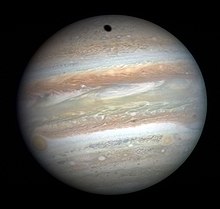气态巨行星


气态巨行星(英语:Gas Giant,又称类木行星)是主要由氢和氦组成的巨行星。太阳系的木星和土星是气态巨行星。“气态巨行星”起初原本是“巨行星”的代名词(同义词),但是1990年代学界意识到天王星和海王星是与气态巨行星不同性质的巨行星,主要是较重的挥发性物质(其性质与冰类似),因此称它们是冰巨行星。木星和土星主要由氢和氦组成,更重的其它元素大约分别占3%和13%[1]。它们被认为外层是分子氢包围着液态的金属氢,可能有着熔融的岩石核心。最外面的一层是氢的大气层,其特点是可见多层由水和氨组成的云。金属氢组成了每颗巨大的气态巨行星,之所以会被称为金属是因为非常大的压力使氢变成导电体。气态巨行星有着“外冷内热”的特质,他们的核心被认为有高温(20,000K)和高压,但对它们的属性了解甚少[1]。
专门名词
“气态巨行星”这个名词是科幻小说家詹姆斯·布利希在1952年创造出来的,当时是指所有的巨行星,但这个名词不完全精确,因为所有体积巨大的巨行星内部都有很高的压力,所以物质不会全部都是气体的形态[2];除了在核心的固体和大气层的上层,所有的物质都是在临界点以上,在那里没有液体和气体之间的区别。在叙述上之所以使用这个名词是因为行星科学家通常使用岩石、气体和冰的速记符号来描述所发现行星的元素、成分和分类,而不管那些物质的位相;在外太阳系的属性归类上,氢和氦为气体,水、甲烷和氨为冰,硅酸盐和金属为岩石。此外,天王星和海王星的成分主要是在此分类中所谓的冰,而不是气体,所以越来越多的科学家将它们归类为冰巨行星,与气态巨行星有所区别。
系外行星
冷气态巨星
低温、富含氢气的气态巨行星,但质量低于500地球质量(1.6木星质量),体积只会略大于木星[3]。质量超过500地球质量,重力会导致行星的收缩[3](参见简并物质)。
开尔文-亥姆霍兹加热会导致一颗气体巨行星辐射出比从母恒星接收到的更多的能量[4][5]。
气态矮行星
虽然是气态和巨大两个单词的结合,但氢行星家族并不都需要像太阳系的气态巨行星一样的巨大。然而较小的气态巨行星和行星,接近它们的母恒星时会比大的行星更快的流失其大气层的质量[6][7]。
气态矮行星可以定义为有着由氢、氦、和其它挥发物的浓厚大气层,和有岩石的核心,其总半径在1.7至3.9地球半径[8]。
已知最小的系外行星,可能是一颗气态行星开普勒138d,它的质量大约是地球的60%,因此这显示它有着浓厚的大气层[9]。
一颗低质量的气态巨行星如果有适宜的温度,仍然可以有类似气态巨行星的半径[10]。
分类
|
主条目:萨达斯基太阳系外行星分类法 |
理论上,气态巨行星可以按其建模的大气物理特性,从其外观分为五类:(I)氨云、(II)水云、(III)无云、(IV)碱金属、和(V)硅云。木星和土星都是第I类;热木星是IV或V。
参考文献
- ^ 1.0 1.1 The Interior of Jupiter, Guillot et al., in Jupiter: The Planet, Satellites and Magnetosphere, Bagenal et al., editors, Cambridge University Press, 2004
- ^ D'Angelo, G.; Durisen, R. H.; Lissauer, J. J. Giant Planet Formation. S. Seager. (编). Exoplanets. University of Arizona Press, Tucson, AZ. 2011: 319–346 [2015-07-02]. Bibcode:2011exop.book..319D. arXiv:1006.5486
 . (原始内容存档于2015-06-30).
. (原始内容存档于2015-06-30).
- ^ 3.0 3.1 Seager, S.; Kuchner, M.; Hier-Majumder, C. A.; Militzer, B. Mass-Radius Relationships for Solid Exoplanets. The Astrophysical Journal. 2007, 669 (2): 1279–1297. Bibcode:2007ApJ...669.1279S. arXiv:0707.2895
 . doi:10.1086/521346.
. doi:10.1086/521346.
- ^ Patrick G. J. Irwin. Giant Planets of Our Solar System: Atmospheres, Composition, and Structure. Springer. 2003. ISBN 3-540-00681-8.
- ^ Class 12 - Giant Planets - Heat and Formation. 3750 - Planets, Moons & Rings. Colorado University, Boulder. 2004 [2008-03-13]. (原始内容存档于2016-03-03).
- ^ Feng Tian; Toon, Owen B.; Pavlov, Alexander A.; De Sterck, H. Transonic hydrodynamic escape of hydrogen from extrasolar planetary atmospheres. The Astrophysical Journal. March 10, 2005, 621: 1049–1060. Bibcode:2005ApJ...621.1049T. doi:10.1086/427204. CiteSeerX: 10.1.1.122.9085
 .
.
- ^ Mass-radius relationships for exoplanets, Damian C. Swift, Jon Eggert, Damien G. Hicks, Sebastien Hamel, Kyle Caspersen, Eric Schwegler, and Gilbert W. Collins
- ^ Three regimes of extrasolar planets inferred from host star metallicities (页面存档备份,存于互联网档案馆), Buchhave et al.
- ^ Earth-mass exoplanet is no Earth twin – Gaseous planet challenges assumption that Earth-mass planets should be rocky. [2015-07-02]. (原始内容存档于2014-01-07).
- ^ *Mass-Radius Relationships for Very Low Mass Gaseous Planets (页面存档备份,存于互联网档案馆), Konstantin Batygin, David J. Stevenson, 18 Apr 2013
参见
| |||||||||||||||||||||||||||||||||||||||||||||||||||||||||||||||||||||||||||||||||||
Text is available under the CC BY-SA 4.0 license; additional terms may apply.
Images, videos and audio are available under their respective licenses.


